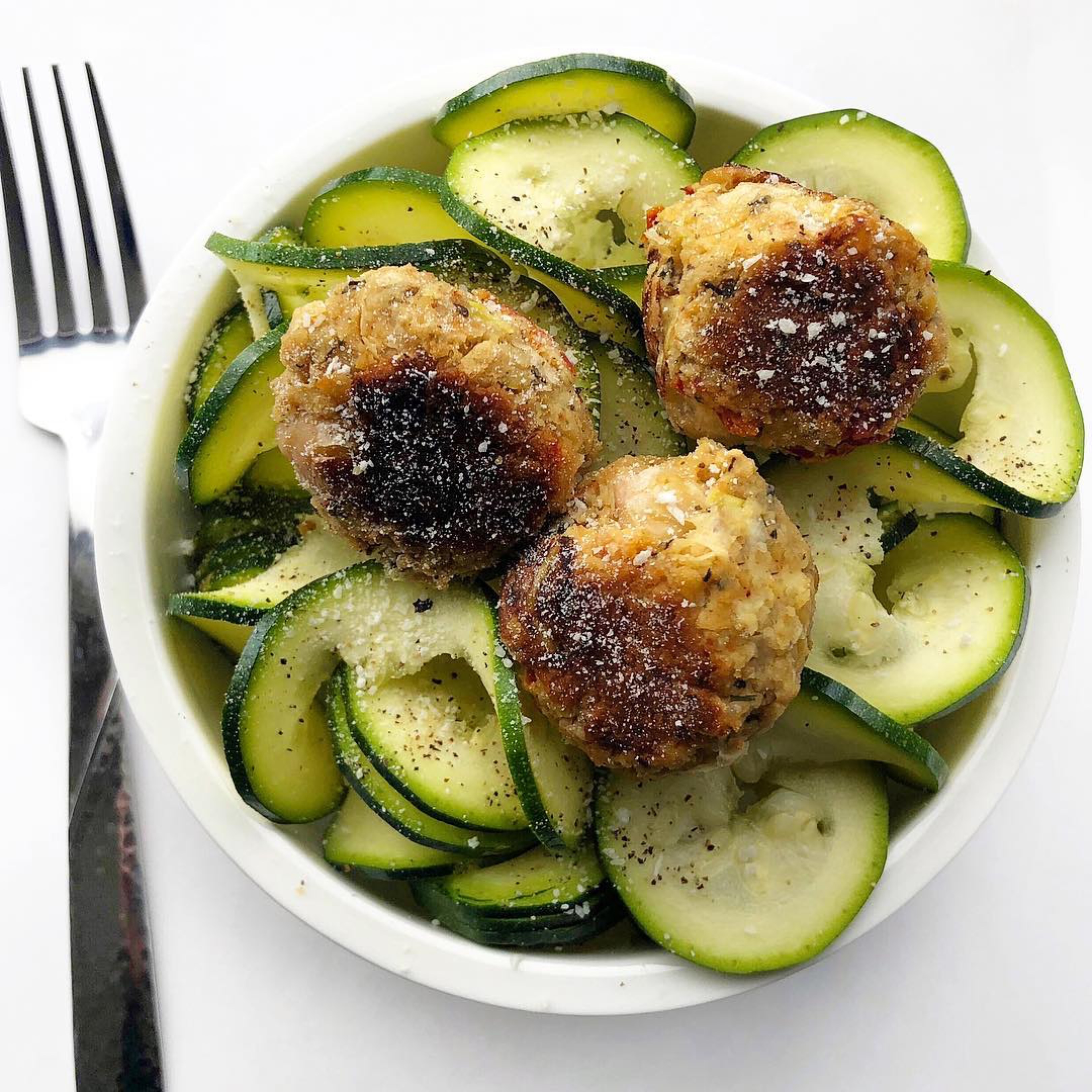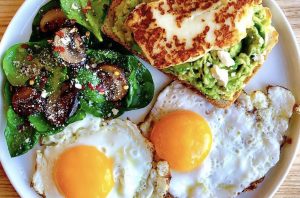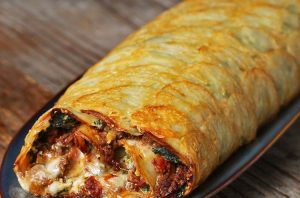
You overate, now what? That feeling after overeating can be a really uncomfortable one. It can make you feel tired and like you have low energy. It can hurt your stomach and even make you feel like you need to unbutton your pants (been. there). While these feelings aren’t fun to feel, they’re also normal.
It makes sense that you’d feel tired and maybe need a little more room around your waist after overeating. An excess of food at once can cause our blood sugar to drop, making us feel more tired. And our stomachs were made to expand – they can hold up to a liter of food!
But, what also often happens after overeating is that consequential guilt. Thoughts might come up such as: “I shouldn’t have eaten that,” “I’m so mad I ate that,” “I’m so bad,” or even “I feel gross.” You probably already know that there’s nothing helpful about these thoughts. It’s totally not fun feeling tired, overfull and making yourself feel like an awful human being just for eating a little more than usual. So, what do you do when you overeat and how do you prevent those unhelpful feelings and thoughts?
First, let’s quickly define what overeating means. Obviously, there’s no objective amount here. Being able to recognize and satisfy your hunger and fullness levels is really important but also can be really hard to do. I like to look at this way: If we look at hunger on a scale from 1-10, where a 1 means you’re so hungry you’ll pass out if you don’t eat something, and a 10 means you’re Thanksgiving-food-coma full, we’d put any of these uncomfortable, post-overeating feelings around a 9-10 on that scale.
So, we’re not talking about eating a few extra bites of ice cream that you were loving. We’re talking about those times when you might eat a little less mindfully and don’t realize how much you’re eating, or when you’re out with friends or at a holiday dinner with more food than usual, or just have meals spaced closer together than they normally are in a given day. None of these occasions are bad– they’re what happens when you’re enjoying life! But, when you overeat to the point of feeling tired, uncomfortable, and unhappy, you need a plan to put in action. Here’s yours:
1. Acknowledge that you overate.
This one probably sounds a little silly, but it’s important. One of the first steps to mindful eating overall is to be aware of the eating process: How does the food taste? Are you enjoying it? How full are you feeling? These are helpful quick check ins to have for the future. But, once you’ve already overeaten, try to check in with your fullness. Are you uncomfortable or tired? Or are you just a little overfull but know it’ll pass in a few minutes? Silently and briefly (we’re not talking about 20 minute analysis here), do a quick check.
Once you’ve acknowledged this feeling, you’ll become more attune to it in the future. For example, if you feel super uncomfortable after mindlessly eating a few extra slices of pizza with friends, and you check in with that feeling, you’re more likely to be more aware the next time you’re in this situation. You’ll remember how you felt the last time you had pizza with friends, and be able to check in before grabbing that 4th or 5th slice that maybe you’re not quite hungry for.
For the time being, once you’ve determined that you are a little too full, keep following the steps below.
2. Drink some water.
Water is a must. Seriously. Nothing helps everything in your body just work like a nice glass of water. It helps hydrate you – especially if you ate salty food – give you energy, and flush out your body. Meaning: if you ate a little more than you were hungry for, drinking plenty of water can help move that food along in your body and help get it out of your body.
Caveat: please do not take this to the extreme and drinks gallons of water. I promise, there’s a limit here and more water is not the merrier. Have a glass or 2 and see how you feel. Any more than that though, and you risk seriously overfilling your stomach (and having to pee waaaay more often than you’d probably like to!).
3. Eat again when you’re hungry.
This is the most important step. Eat again when you’re hungry. Just because you overate this one time, does not mean you need to punish yourself going forward. Sure, maybe you ate more than usual, but it does not mean that you’ve “used up” all your calories for the day. It also doesn’t mean that you’re not allowed to eat again until the next day. And finally, it doesn’t mean that you should “screw it” and binge eat for the rest of the day. That’ll only make yourself feel even worse! Please, treat your body a little more nicely than all of that.
Instead, consider when you’re hungry next. If you overate at lunchtime around 12pm, and normally you eat a snack around 3pm, maybe you won’t be hungry for your 3pm snack. Or maybe you will. Check in with your body and, most importantly, continue to eat regular meals and snacks like you normally would as soon as you’re hungry again. Not low calorie meals or low carb meals – normal, balanced meals. Continuing to eat normal meals and snacks when you’re hungry helps your metabolism keep going and keeps your energy level up.
Our bodies do a great job at understanding what and how much they need. Just because you overate at one point in time does not mean you need to punish your body with only salads and green juice for the remainder of the week.
4. Bonus: remember that one meal will not make or break your health.
I talk about this a lot in All Foods Fit, but really, one meal will not make or break your health. Everything about your overall health, and even your weight, is based on the big picture: how balanced and varied your meals are in general, how active you are overall, and so much more. In the scheme of things, one meal means pretty much nothing compared to the big picture overall.
If you’re able to remember that one, single meal will have zero effect on your health overall, you’ll be able to much more easily move forward, move on with your day and get rid of any of those unhelpful, negative feelings.
—
By taking steps to acknowledge your fullness, make yourself feel more comfortable and continue to eat regularly instead of punishing yourself, you’re helping yourself overcome not only that post-overeating discomfort, but also those feelings of guilt and shame.
It’s really, really important to understand that overeating is normal. Yes, it’s helpful to understand your hunger and fullness levels and try to honor them as much as possible. But you’re human. And there isn’t a single person who eats exactly when they’re hungry or stops precisely when they’re full every. single. time they eat. Overeating is a normal part of life and, a lot of the time when it happens, means you’re enjoying life too.
It happened once, and it will happen again. Spoiler alert: you’ll probably overeat often over the course of your life. It’s unreasonable to expect that you’ll never overeat ever again. But, knowing that it happens and understanding what to do next makes all the difference in going down a black hole of feeling badly about yourself versus simply moving on with your day. Trust me, you’ll be much happier with that latter option.
To learn more about recognizing your hunger and fullness, check out All Foods Fit, a membership program that teaches everything you need to know about hunger, fullness, healthy eating and more.
Become a VIP member
Meal details: chickpea meatballs with lightly sautéed zoodles

Put a twist on classic spaghetti and meatballs with this delicious plant based version! Making over a traditional main course meal is very fun and helps you stay on track with your health goals without sacrificing flavor
Ingredients
Vegetarian Mushroom Meatballs:
* 2 cups of mushrooms finely chopped
* 1 cup drained/cooked chickpeas
* 1 cup cooked quinoa
* 1 large onion peeled and finely diced
* 5 Tbsp olive oil
* 4 garlic cloves peeled and crushed
* 1 Tbsp finely chopped fresh rosemary (leaves only)
* 1 Tbsp finely chopped fresh thyme (leaves only)
* 1 Tbsp chia seeds
* 1 tsp dried oregano
* 1 tsp salt
* 1 tsp liquid aminos (optional)
* juice of one lemon
* freshly ground black pepper
Marinara or Tomato Sauce and Zucchini Noodles are also used for this recipe!
Marinara or Tomato Sauce and Zucchini Noodles are also used for this recipe!
Instructions
1. Making the Meatballs:
2. In a large non-stick skillet, add 1 tbsp oil and let it heat for 30 seconds.
3. Add onions and saute till golden brown.
4. Now add mushrooms, garlic and saute till mushrooms become slightly cooked (about 2 minutes).
5. Saute till the water from mushroom is almost evaporated and then turn off the heat.
6. Let the mushrooms cool down completely.
7. Now, add the chickpeas, mushroom mix, quinoa, herbs, and the rest of the ingredients in a food processor.
8. Pulse to form a crumbly dough.
9. Scoop the dough to a clean surface and divide it into equal balls.
Cooking the Meatballs:
1. Heat a skillet and add 2 tbsp oil.
2. Place 7-8 meatballs (or as many your pan accommodate) in the pan and lightly cook them over medium heat.
3. Turn them slowly to prevent them from breaking and cook till the entire meatball is golden brown
4. OR
5. You can line them on a baking tray and spray some cooking oil on all sides. Bake for 400F for 15 minutes.
Heat the Sauce.
Serving the Vegetarian Meatballs with Zoodles:
Sautee the zoodles very lightly in a pan or place them on a serving plate raw. Either way is fine!
In a serving plate, place some zoodles in the bottom.
Now add 3-4 meatballs on top and pour 2-3tbsp marinara sauce on the top. (you can add less or more).
Serve Immediately
If you want to make your own sauce here is a recipe:
Tomato Sauce:
* 2 Tbsp olive oil
* 2 onions peeled and finely diced
* 2 carrots peeled and finely diced
* 3 cloves garlic peeled and crushed
* small bunch fresh basil
* 2 Tbsp tomato puree
* 4 cups of chopped tomatoes
* 250 ml (1 cup) water
* 2 bay leaves
* 1 tsp oregano
* 1 tsp crushed red pepper
* 1 tsp sugar
* salt and pepper
Instructions for Tomato Sauce:
1. In a large bowl, blend the cooked chopped tomatoes and carrots with a blender or hand-blender.
2. In a large pot, heat the oil over medium-low heat. Add onions and garlic, and cook until softened but not browned, 2-3 mins. Add oregano, crushed red chili pepper, salt and pepper and cook, stirring, for 30 seconds. Stir-in the crushed tomatoes mixture and sugar, and bring to a simmer. Add basil and bay leaves. Add salt to taste and reduce heat to low, partially cover and simmer, stirring occasionally, 45 minutes to 1 hour.
Source: By @veggiesandchocolate, Release well being centre
Who’s ever overeaten before?
Let’s be real: everyone has. Overeating is suuuper normal. It’s actually pretty unrealistic to expect to never overeat, ever. No one eats exactly when they’re hungry and stops exactly when they’re full every. single. time. they eat. But, it’s also not a fun feeling, right?! Overeating can make you feel uncomfortable, tired and even guilty. If this sounds familiar, keep reading
-
One of the most important things you can do after overeating is to acknowledge that it happened and check in with how you feel. Are you totally overstuffed after eating pizza with friends? Check in with that feeling. And next time you get pizza with friends, you’ll remember more easily to check in with your fullness at slice 2 or 3. Being more aware of how you feel this one time will help you eat more mindfully in the future and prevent that uncomfortable, overeating feeing
Source: By @veggiesandchocolate
Peanut butter bars

No bake chocolate peanut butter protein bars that taste just like a peanut butter cup. This low carb protein bar recipe will be your new favorite snack to keep in your fridge and enjoy all week long!
These chocolate peanut butter protein bars are easy to make because there’s no baking required. All you need is an a pot or two, an 8×4 inch loaf pan, parchment paper and 7 simple ingredients:
peanut butter: you can use whatever kind of nut butter you’d like, just make sure it’s all natural (with no additives — just nuts + salt). I like Smucker’s, Santa Cruz, Trader Joe’s or Whole Foods natural creamy peanut butter.
honey: this unrefined sweetener is perfect for holding together + sweetening the bars. If you are vegan, I suggest using coconut palm syrup or date syrup.
coconut oil: you’ll only need a tablespoon of coconut oil!
vanilla extract: I’m such a vanilla lover, but if you find yourself out of vanilla, feel free to skip it!
flaxseed meal: flaxseed meal is just ground flaxseeds! I absolutely LOVE how it adds fiber + protein to these bars. It does give the bar a nice toasty flavor too.
protein powder: you can use plant based or a whey protein. My personal favorite is Vital Proteins collagen peptides (which is dairy free) but I also love aloha vanilla plant based protein powder for this recipe. Those are the two I highly recommend for flavor and consistency in this recipe.
dark chocolate: you can use your favorite brand of dark chocolate. I recommend theo, divine or alter eco brands. Alter eco has a lot of great dairy free/vegan options!
Optional: a little fancy sea salt for sprinkling on top.
These bars are seriously one of my favorite healthier treats to make because they’re so freaking easy and do NOT require any baking. They also make an excellent post workout snack or late afternoon pick me up as they happen to pack 9g protein.
Nutrition info
Serves 10 210 calories
Type: No Bake, Gluten Free, Grain Free, Dairy Free
Prep time: 10 mins
Cook time: 30 mins
Total time: 40 mins
INGREDIENTS
* ¾ cup natural creamy peanut butter (just peanuts + salt)
* ¼ cup honey (or coconut palm syrup, if vegan)
* 1 tablespoon melted coconut oil
* 1 teaspoon vanilla
* 1/3 cup ground flaxseed meal
* 1/2 cup of your favorite vanilla or plain protein powder*
* 2.5 ounces your favorite 85% dark chocolate bar
* Coarse sea salt for sprinkling on top
INSTRUCTIONS
1. In a medium bowl mix together peanut butter, honey, coconut oil, vanilla together until smooth. Add in ground flaxseed meal and protein powder of choice. Use a spoon to mix together until you can’t anymore, then use clean hands to help work together. The batter should be similar to cookie dough.
2. Press into an 8x4 inch pan lined with parchment paper.
3. Make the chocolate layer by adding 2.5 ounces of dark chocolate to a small saucepan and melting until completely smooth. Pour the melted chocolate over the peanut butter layer and tilt the pan so that the chocolate covers the peanut butter layer entirely. Place in the fridge for 30 minutes-1 hour before slicing into 10 bars or squares (either works but I love squares the most). Store covered in the fridge until ready to eat. Bars will keep for up to two weeks.
NOTES
*Note: if the batter feels too dry, add ½ - 1 tablespoon of melted virgin coconut oil
For the protein powder: you can use plant based or a whey protein. My personal favorite is Vital Proteins collagen peptides (which is dairy free) but I also love aloha vanilla plant based protein powder for this recipe. Those are the two I highly recommend for flavor and consistency in this recipe.
Source: @ambitiouskitchen’s








